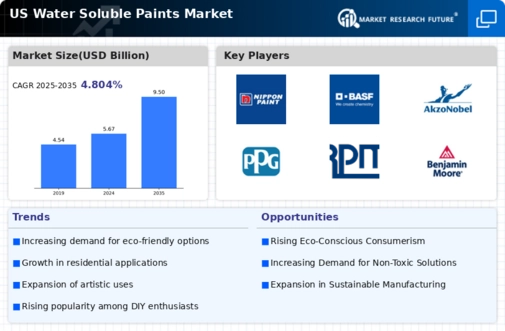The US Water Soluble Paints Market is characterized by a dynamic competitive landscape marked by several prominent players who have established themselves through innovation, quality, and sustainability. As consumers increasingly prioritize eco-friendly products, water soluble paints have gained popularity due to their lower environmental impact, reduced VOC emissions, and ease of cleanup.
Companies in this market are continually adapting their strategies to respond to shifting consumer preferences and stringent regulations, which drive them to enhance their product offerings and invest heavily in research and development. This sector is also witnessing growing interest from manufacturers looking to diversify their product lines to include more sustainable options, indicating a trend towards greener alternatives in the coatings industry.
Nippon Paint stands out in the US Water Soluble Paints Market with a strong emphasis on innovation and quality. The company has leveraged its extensive research and development capabilities to introduce a range of high-performance water soluble paints tailored to various applications. Nippon Paint is recognized for its commitment to sustainability, which resonates well with environmentally-conscious consumers in the US market.
Their strategic partnerships and collaborations with local distributors have bolstered their market presence, allowing for effective distribution of their products. Furthermore, Nippon Paint has invested in marketing initiatives that highlight the benefits of water soluble paints, enhancing brand awareness and fostering customer loyalty within the competitive landscape of the US.
BASF holds a significant position in the US Water Soluble Paints Market, offering an array of ingredients and solutions tailored for water-based coatings. The company’s portfolio includes key products that are designed to meet diverse customer needs, ranging from decorative paints to specialized coatings for industrial applications.
BASF's strengths lie in its extensive research capabilities and strong emphasis on innovation, enabling it to consistently deliver high-quality products that meet regulatory standards and customer expectations in the US. Through strategic mergers and acquisitions, BASF has expanded its reach and capabilities within the market, allowing for improved product offerings and enhanced operational excellence.
The company has also reinforced its commitment to sustainability by developing eco-friendly paint formulations, ensuring its competitive edge while addressing consumer demands for sustainable and health-conscious products.
























Leave a Comment